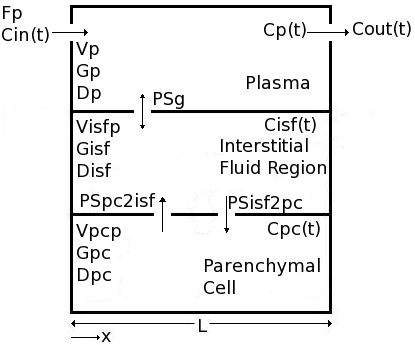A capillary-ISF-cell convection diffusion model, modified BTEX30 with a Michaelis-Menten saturable transporter on the pc membrane. It is represented by two separated and independent unidirectional transporters, each governed by the fractional saturation in the source compartment, i.e. by the concentration in the ISF to define PSISF2pc, and in the pc, Cpc, to define PSpc2ISF, the conductance via the carrier from pc to ISF. A three region two-side Michaelis-Menten transporter model.
Detailed Description

This model is almost the same as TranspMM.2sided.Distrib2F.proj but differs in the form of the transporter. In this program the two opposite fluxes are independent. In the .Distrib2F.proj model the conductances are identical for the two directions.
BTEX stands for blood-tissue exchange, 3 denotes 3 regions, 0 indicates a basic model. The 3 regions are the convecting plasma, p, and stagnant ISF and parenchymal cell, pc. Axial gradients exist in all three regions. Each region is considered radially uniform on the basis that radial diffusion distances are so short that diffusional relaxation times are at most a few miolliseconds and can be considered instantaneous. The endothelial cell is considered as a passive barrier without capacitance and has permeability-surface area product, PSg, where the subscript g indicates the interendothelial clefts. The organ parenchymal cells, pc, here has a saturable PSpc.
Consumption in all regions is by simple first order reactions with rate constant G. Axial diffusion occurs in all regions, Dp, DISF, and Dpc. Capillary mean transit time is Vp/Fp, physical velocity is L/(Vp/Fp).
Relevant Equations





We welcome comments and feedback for this model. Please use the button below to send comments:
Bassingthwaighte JB. A concurrent flow model for extraction during transcapillary passage. Circ Res 35: 483-503, 1974. (This gives numerical solutions, which are faster than the analytic solutions, and imbeds the model in an organ with tissue volums conserved, and with arteries and veins. The original Lagrangian sliding fluid element model with diffusion.)
Klingenberg M. Membrane protein oligomeric structure and transport function. Nature 290: 449-454, 1981.
Stein WD. The Movement of Molecules across Cell Membranes. New York: Academic Press, 1967.
Stein WD. Transport and Diffusion across Cell Membranes. Orlando, Florida: Academic Press Inc., 1986.
Wilbrandt W and Rosenberg T. The concept of carrier transport and its corollaries in pharmacology. Pharmacol Rev 13: 109-183, 1961.
Schwartz LM, Bukowski TR, Ploger JD, and Bassingthwaighte JB. Endothelial adenosin transporter characterization in perfused guinea pig hearts. Am J Physiol Heart Circ Physiol 279: H1502-H1511, 2000.
Dawson CA, Linehan JH, Rickaby DA, and Roerig DL. Influence of plasma protein on the inhibitory effects of indocyanine green and bromcresol green on pulmonary prostaglandin E1 extraction. Br J Pharmac 81: 449-455, 1984.
Crone C. Facilitated transfer of glucose from blood into brain tissue. J Physiol 181: 103-113, 1965.
Copyright (C) 1999-2009 University of Washington. From the National Simulation Resource, Director J. B. Bassingthwaighte, Department of Bioengineering, University of Washington, Seattle WA 98195-5061. Academic use is unrestricted. Software may be copied so long as this copyright notice is included. This software was developed with support from NIH grant HL073598. Please cite this grant in any publication for which this software is used and send one reprint to the address given above.
Model development and archiving support at https://www.imagwiki.nibib.nih.gov/physiome provided by the following grants: NIH U01HL122199 Analyzing the Cardiac Power Grid, 09/15/2015 - 05/31/2020, NIH/NIBIB BE08407 Software Integration, JSim and SBW 6/1/09-5/31/13; NIH/NHLBI T15 HL88516-01 Modeling for Heart, Lung and Blood: From Cell to Organ, 4/1/07-3/31/11; NSF BES-0506477 Adaptive Multi-Scale Model Simulation, 8/15/05-7/31/08; NIH/NHLBI R01 HL073598 Core 3: 3D Imaging and Computer Modeling of the Respiratory Tract, 9/1/04-8/31/09; as well as prior support from NIH/NCRR P41 RR01243 Simulation Resource in Circulatory Mass Transport and Exchange, 12/1/1980-11/30/01 and NIH/NIBIB R01 EB001973 JSim: A Simulation Analysis Platform, 3/1/02-2/28/07.

